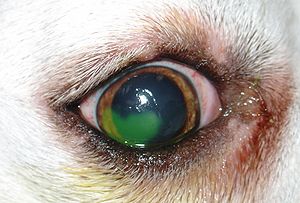 Image via Wikipedia
Image via WikipediaMy search for information on the condition revealed an informative article from the American Shih Zu Club website. I found the following excerpts to be of particular interest. http://americanshihtzuclub.org/corneal_ulcers
"Corneal ulceration, also known as ulcerative keratitis, occurs in all breeds of dog, but brachycephalic breeds with pushed-in faces, such as Shih Tzu, Bulldog, French Bulldog, Lhasa Apso, Pekingese, and Pug, are more commonly affected. Age doesn’t seem to play a role in development of corneal ulcers, although most cases occur in young to middle-aged dogs...
The cornea is the transparent layer in the front of the eye that covers the iris, pupil and anterior chamber. When a dog develops a corneal ulcer, it first affects the epithelium, or the protective outer layer of the cornea. The epithelium prevents water and infectious agents from entering the cornea and holds the tear film in place...
Corneal ulcers usually result from trauma to the eye. In the case of Stern’s dog, Ledger, he experienced irritation and eventually pustules formed from the rubbing of the abnormal growth of eyelashes, caused by distichiasis, on the cornea. Ulcers also can be related to decreased tear production, eyelid abnormalities or nerve damage...
Signs of an ulcer include blinking, squinting or rubbing the eye. Most of the nerves in the cornea are on the surface, so as the ulcer goes deeper into the eye, the pain may lessen though the condition is worsening. Brachycephalic breeds are less likely to show signs of pain than other breeds because their corneal sensitivity tends to be decreased..."
The described sign of ulcer are consistent with what we observed with Gus. Upon arriving home last night from work, Gus greeted my but only briefly before rubbing his face again the edge of the open door. I looked at him and he gazed back, one eye open, the other shut. Of course our first though was that he had something in his eye so we tried to flush it with saline solution. After two attempts and no sign of improvement we decided to take him to the clinic. Our experience with Lulu has left an impression. We are really the "wait and see" kind of dog parents anymore.
The vet thought Gus's condition was likely caused by dry eye since he hasn't been getting much "play time" with Lu so injury was unlikely. He said it's common in certain breeds like the French Bulldog to sleep with their eyes partially open which lends to the dry eye issues. Even after the numbing treatment at the clinic, Gus was still clearly uncomfortable and kept the affected eye pinched shut. At home when he finally fell asleep we saw that true to the vet's assumption, the left eye was partially open in sleep. Unconscious, the right eye must have been irritated then as it was closed all the way.
Lulu is grumpy today. I'm not sure if it's the new attention Gus is getting or if she's not feeling well. She has a little bit of a runny nose anyway. Maybe she's trying to the turn the table. Usually it's Gus vying for attention. In fact, when Lu had surgery to remove the scabious cyst on her neck, Gus pulled out a nail the same day she was released. The little rascal.

No comments:
Post a Comment